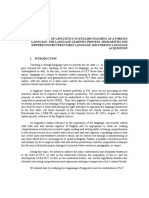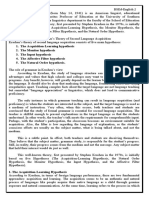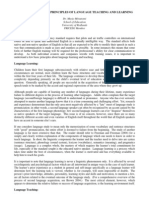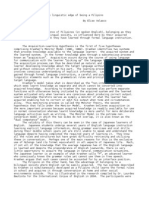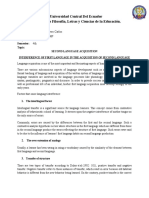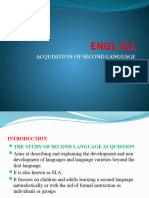EL103 Module 8
EL103 Module 8
Uploaded by
Zandra Loreine AmoCopyright:
Available Formats
EL103 Module 8
EL103 Module 8
Uploaded by
Zandra Loreine AmoOriginal Description:
Copyright
Available Formats
Share this document
Did you find this document useful?
Is this content inappropriate?
Copyright:
Available Formats
EL103 Module 8
EL103 Module 8
Uploaded by
Zandra Loreine AmoCopyright:
Available Formats
Republic of the Philippines
NORTHERN ILOILO STATE UNIVERSITY
Barotac Viejo Campus, Brgy. Puerto Princesa, Barotac Viejo, Iloilo
Module 8: Lessons 1 - 7
LANGUAGE LEARNING AND LANGUAGE ACQUISITION ON FOCUS
I. INTRODUCTION
When we think of "language learning" we need to understand two clearly distinct concepts. One
involves receiving information about the language, transforming it into knowledge through intellectual
effort and storing it through memorization. The other involves developing the skill of interacting with
foreigners to understand them and speak their language. The first concept is called "language learning,"
while the other is referred to as "language acquisition." These are separate ideas and we will show that
neither is a natural consequence of the other. The distinction between acquisition and learning is one of
the hypotheses (the most important) established by the American Stephen Krashen in his highly regarded
theory of foreign language acquisition known as the Natural Approach.
II. LEARNING OUTCOMES
Upon completion of this module, you should have:
Discussed and described language learning and language acquisition in detail
Described the relationship between acquisition and learning
III. LEARNING CONTENT
Lesson 1: LANGUAGE LEARNING AND LANGUAGE ACQUISITION
LANGUAGE ACQUISITION. Language acquisition refers to the process of natural
assimilation, involving intuition and subconscious learning. It is the product of real interactions between
people in environments of the target language and culture, where the learner is an active player. It is
similar to the way children learn their native tongue, a process that produces functional skill in the spoken
language without theoretical knowledge. It develops familiarity with the phonetic characteristics of the
language as well as its structure and vocabulary, and is responsible for oral understanding, the capability
for creative communication and for the identification of cultural values. In acquisition-inspired
methodology, teaching and learning are viewed as activities that happen on a personal and psychological
level. The acquisition approach praises the communicative act and develops self-confidence in the
learner. A classic example of second language acquisition are the adolescents and young adults that live
abroad for a year in an exchange program, often attaining near native fluency, while knowing little about
the language. They have a good pronunciation without a notion of phonology, don't know what the
perfect tense is, modal or phrasal verbs are, but they intuitively recognize and know how to use all the
structures.
LANGUAGE LEARNING. The concept of language learning is linked to the traditional
approach to the study of languages and today is still generally practiced in high schools worldwide.
Attention is focused on the language in its written form and the objective is for the student to understand
the structure and rules of the language, whose parts are dissected and analyzed. The task requires
intellectual effort and deductive reasoning. The form is of greater importance than communication.
Teaching and learning are technical and based on a syllabus. One studies the theory in the absence of the
practice. One values the correct and represses the incorrect. Error correction is constant leaving little
room for spontaneity. The teacher is an authority figure and the participation of the student is
EL 103 Principles and Theories of Language Acquisition and Language Learning
Module 8, Lessons 1 – 7 Page 1 of 5
predominantly passive. The student will be taught how to form interrogative and negative sentences, will
memorize irregular verbs, study modal verbs, learn how to form the perfect tense, etc., but hardly ever
masters the use of these structures in conversation. Language-learning inspired methods are progressive
and cumulative, normally tied to a preset syllabus that includes memorization of vocabulary. It seeks to
transmit to the student knowledge about the language, its functioning and grammatical structures, its
contrasts with the student's native language, knowledge that hopefully will produce the practical skills of
understanding and speaking the language. However, the effort of accumulating knowledge about the
language with all its irregularity becomes frustrating because of the lack of familiarity with the language.
Lesson 2: INTERRELATIONSHIP BETWEEN ACQUISITION AND LEARNING AND ITS
IMPLICATIONS
The clear understanding of the differences between acquisition and learning makes it possible to
investigate their interrelationships as well as the implications for the teaching of languages. First, we
ought to consider that languages are complex, arbitrary, irregular phenomena, full of ambiguities, in
constant random and uncontrollable evolution. Therefore, the grammatical structure of a language is too
complex and abstract to be categorized and defined by rules. Even if some partial knowledge of the
functioning of the language is reached, it is not easily transformed into communication skills. What
happens in fact is the opposite: to understand the functioning of a language with its irregularities is a
result of being familiar with it. Rules and exceptions will make sense and grammar, word choice and
pronunciation will be employed appropriately if it "sounds" right. Language analysis and the deductive,
rule-driven study of grammar are not only ineffective to produce communicative ability, but also
frustrating. It is much easier and more enjoyable to acquire a language than it is to learn a language. In his
Monitor Hypothesis Krashen admits that the knowledge obtained through formal study (language
learning) can serve to monitor speaking. Krashen, however, doesn't specify the language that would be
the object of study, but it is logical to assume that he was using the study of Spanish as the basis for his
inferences and conclusions because it is the dominant foreign language in the United States, and
particularly in the state of California, where Professor Krashen lives and works. Therefore, it is necessary
to analyze the characteristics of the target language, their degrees of irregularity and difficulty and how
that affects the applicability of Krashen's theory. It is also necessary to analyze the personal
characteristics of the players in the teaching-learning arena.
Lesson 3: THE LEVEL OF IRREGULARITY OF THE LANGUAGE AND THE EFFICIENCY
OF ACQUISITION VS. LEARNING
EL 103 Principles and Theories of Language Acquisition and Language Learning
Module 8, Lessons 1 – 7 Page 2 of 5
The effectiveness of the monitoring function (made possible by the knowledge of grammar rules)
is directly proportional to the degree of regularity of the target language. If there is regularity, there can
be a rule and such a rule will be useful to produce and monitor language. The lower the regularity, the
fewer the rules and the more limited the monitoring. One of the most important aspects in the learning of
a foreign language is its oral production. This fundamental skill is subject to an inhibitory and persistent
interference from one of the main irregularities of English: the oral interpretation of the written word.
SPELLING TO SOUND CORRESPONDENCE: Spanish shows a much higher degree of
regularity when compared to English, especially in its almost perfect correlation between the written
language and its pronunciation. Therefore, when interpreting Krashen's theory we can infer that his
conclusions concerning the superiority of acquisition over learning would have been more emphatic if the
object of study and analysis had been English as the target language instead of Spanish.
WORD STRESSING: The unpredictability of word stressing in English with five possibilities
against only three in Portuguese, coupled with the absence of any indication of stress from spelling, is
another element that adds irregularity and difficulty and supports the idea that acquisition-inspired EFL
teaching in Brazil is likely to be more effective than learning-inspired teaching. There are still many other
points of contrast between English and Spanish that show the greater degree of irregularity of English.
The fact is that even with a target language with a large degree of regularity such as Spanish, the
contribution of learning will only be effective and durable if the student simultaneously develops
familiarity and skill with the language in natural environments.
Lesson 4: THE DEGREE OF PHONETIC SIGNALING IN THE LANGUAGE AND THE
INEFFICIENCY OF LEARNING
It's easy to assess the degree of phonetic signaling of languages and understand its importance. If we
analyze and compare Spanish and Portuguese with English, we conclude that there is a significant
difference, being English considerably more economical and compact than the Romance languages. This
means a greater difficulty in speech recognition of the target language when going from Portuguese or
Spanish to English than going the opposite direction. It also means that more time needs to be devoted to
the practice of the spoken language (especially listening) and less time spent on translation, grammar
rules and vocabulary memorization.
Lesson 5: INTROVERSION VS. EXTROVERSION IN LANGUAGE LEARNING
The effect of grammar knowledge on a learner's communicative competence depends
significantly on that person's personality. People who tend to be introverts, that show a lack of self-
confidence and often are perfectionists, will benefit little from understanding the grammar of the language
and its irregularities. The result can be even adverse, in the case of languages with a high degree of
irregularity such as English. After years of English learning in high school and language schools, where
natural deviations are classified as errors and are promptly corrected and repressed, the student who is
insecure by his nature will develop a block that discourages spontaneity due to his awareness from
experience that there is a high probability of making an error. On the other hand, people who tend to be
extroverts, who talk too spontaneously, improvising all the time, also benefit little from learning. Their
monitoring function is almost inoperative and subject to an impulsive personality that manifests itself
without much concern with accuracy. The only ones who benefit from learning are people whose
personalities are midway between introvert and extrovert, and manage to apply the monitoring function in
a moderate and effective form. However, this monitoring will only function if there are three
simultaneous conditions: Concern with form: The learner must be concerned with correctness of the
linguistic form in addition to the content of the message. Knowledge of the rules: There must be a rule
that applies to the case and the learner knows the rule and existing exceptions. Time availability: When
producing language, the learner must have enough time to assess the alternatives provided by the
applicable rules.
EL 103 Principles and Theories of Language Acquisition and Language Learning
Module 8, Lessons 1 – 7 Page 3 of 5
Lesson 6: THE EFFECTS OF ACQUISITION VS. LEARNING ON MOTIVATION
Approaches inspired by acquisition or learning will have different effects on the learner’s level of
motivation along the learning process. Acquisition-inspired approaches are normally detached from a
syllabus and naturally more geared towards the learner’s needs and individual goals. They will also have
activities based more on conversation rather than the study of grammar. As a result, they will produce
more readily useful knowledge and raise the level of motivation as the learner builds up his
communicative skills. Learning-inspired approaches, normally tied to a syllabus, will emphasize the
production of knowledge about the target language, especially its grammatical structures, at the expense
of communicative skills. They will hardly meet the learner’s immediate goals. If not offset by a lively and
charismatic teacher, the learning-inspired approach will drain the motivation, especially considering that
proficiency in a foreign language can take a long time to be attained.
Lesson 7: AGE AND THE EFFICIENCY OF ACQUISITION VS. LEARNING
The majority of studies as well as the experience of those in the field of SLA indicate that the lower the
age the easier, the faster and the more complete the learning will be. In the same way that age is a
determining factor in foreign language learning in general, it is also a determining factor in the level of
efficiency of acquisition and learning. Not considering individual differences like personality, motivation,
hearing, and taking the normal learner as a sample, we can say that the lower the age, the more efficient
acquisition will be over learning. At the same time, learning demonstrates to be partially efficient only
during the age of intellectual maturity.
NATIVE VS. NON-NATIVE INSTRUCTOR. Native and non-native teachers have different
talents. Likewise, acquisition-inspired and learning-inspired language programs require different talents.
Language teaching in Brazil is predominantly based on language learning, strictly following a syllabus
and working with the written language or following sequences of lessons with oral drills and repetition
exercises. For this kind of teaching, non-native teachers with the experience of "already having walked
down the same path," may have an advantage over native speakers. In language acquisition, however, the
primary goal is human interaction, in which one functions as a facilitator, providing plenty of
comprehensible input, and through which the other (the learner) selects his own route building his skill in
a direction that interests him personally or professionally. Instead of a syllabus, language acquisition
programs offer intercultural communication through a personal relationship. Here, the presence of
genuine representatives of the language and culture that one intends to assimilate is fundamental. Native
or near-native instructors, therefore, have a clear advantage in a communicative approach, inspired by the
concept of language acquisition.
GROUP SIZE. Group size is vitally important in the implementation of second language
acquisition programs. For acquisition to take place the target language and culture must prevail all the
time in the group activities. The bigger the number of learners, the more difficult the challenge will be for
instructors to impose their language and less personal the interaction with each learner.
CONCLUSION
Krashen finally concludes that language acquisition is more efficient than language learning for
attaining functional skills in a foreign language not only in childhood. Language learning is limited to a
complementary role in the form of support lessons and study materials, and will be useful only for adult
students that have an analytical and reflective learning style and make good use of the monitoring
function. Language learning will also be more useful for languages with a higher level of regularity, as
well as in situations where the number of students per group cannot be reduced. The efficient teaching of
languages isn't that tied to a packaged course of structured lessons based on grammatical sequencing,
translation or oral drilling, nor is the one that relies on technological resources. Efficient teaching is
personalized, takes place in a bicultural environment and is based on the personal skills of the facilitator
in building relationships and creating situations of real communication with comprehensible input
EL 103 Principles and Theories of Language Acquisition and Language Learning
Module 8, Lessons 1 – 7 Page 4 of 5
focusing on the learner's interests.
IV. LEARNING ASSESSMENT
A. Answer the following (using your own words/cite if necessary):
1.Describe language learning
2.Describe language acquisition
V. ENRICHMENT ACTIVITIES
Answer the following:
1. What is Krashen’s take on language learning? On language acquisition?
2. Read another article on language learning and language acquisition and summarize it.
3. Which do you think is more effective, learning a language or acquiring a language? Why?
*the same rubrics and criteria will be used all throughout
VI. REFERENCES
Krashen, S. D. (2009). Principles and Practice in Second Language Acquisition: Pergamon Press
Inc. University of California
Castello, D. (2015). First Language Acquisition and Classroom Language Learning: Similarities
and Differences: ELAL College of Arts & Law University of Birmingham Edgbaston
Birmingham B15 2TT United Kingdom
Brown. H. Douglas (20000. PRINCIPLES of LANGUAGE LEARNING AND TEACHING: San
Francisco State University
Schütz, Ricardo E. "Assimilação Natural x Ensino Formal." English Made in Brazil . Online.
(data do acesso).
EL 103 Principles and Theories of Language Acquisition and Language Learning
Module 8, Lessons 1 – 7 Page 5 of 5
You might also like
- Assignment 7 Week 8Document3 pagesAssignment 7 Week 8EMILY GERARD100% (2)
- How Languages Are Learned Summary Chapter 2Document3 pagesHow Languages Are Learned Summary Chapter 2Elena Leo100% (1)
- Chapter One: 1.1. Language Learning and AcquisitionDocument14 pagesChapter One: 1.1. Language Learning and AcquisitionMuhammad Naeem aka Ibn E HaiderNo ratings yet
- Learning Theories On SlaDocument77 pagesLearning Theories On SlaKhristine Hazel FerreriaNo ratings yet
- Language Acquisition vs. LearningDocument9 pagesLanguage Acquisition vs. LearningCristina Fumagalli MantovaniNo ratings yet
- 6 Contributions of LinguisticsDocument4 pages6 Contributions of LinguisticsTeresa Pajarón LacaveNo ratings yet
- Final Exam SociolinguisticsDocument14 pagesFinal Exam SociolinguisticsKANISKA A/P MAYALAGAN STUDENTNo ratings yet
- Critical Review of Second Language AcquisitionDocument6 pagesCritical Review of Second Language Acquisitionamalia astriniNo ratings yet
- What Is Morphosyntax?: The Relationship Between Age and Second Language Productive AbilityDocument8 pagesWhat Is Morphosyntax?: The Relationship Between Age and Second Language Productive AbilityAlvin Rañosa LimNo ratings yet
- El 103 - Learning Task 6 - Serra, Georgia Alexandria E.Document7 pagesEl 103 - Learning Task 6 - Serra, Georgia Alexandria E.Georgia Alexandria SerraNo ratings yet
- Universidad Del Tepeyac Departamento de IdiomasDocument15 pagesUniversidad Del Tepeyac Departamento de IdiomasSANTIAGO PALACIOS ZAPATANo ratings yet
- ELT 1 Module 3Document4 pagesELT 1 Module 3Kristine CantileroNo ratings yet
- Options in The Teaching of Grammar Otg NotebookDocument24 pagesOptions in The Teaching of Grammar Otg Notebookapi-458181868No ratings yet
- Stephen DDocument5 pagesStephen Ddexie calagNo ratings yet
- Language Learning MitsutomiDocument4 pagesLanguage Learning MitsutomiElkhansa AsnaNo ratings yet
- Inglisero/Inglisera: The Linguistic Edge of Being FilipinoDocument2 pagesInglisero/Inglisera: The Linguistic Edge of Being Filipinoelise100% (1)
- TEMA 2Document13 pagesTEMA 2Patricia GarciaNo ratings yet
- Unit 1: Introduction: Pre-Chapter QuestionsDocument116 pagesUnit 1: Introduction: Pre-Chapter QuestionsFranco KaaminoNo ratings yet
- The Problem and Its ScopeDocument34 pagesThe Problem and Its ScopeaafNo ratings yet
- Interference of First Language in Second Language AcquisitionDocument6 pagesInterference of First Language in Second Language AcquisitionCarlos Alberto Cabezas Guerrero100% (1)
- LTM 1Document10 pagesLTM 1Aas Yulia DasirNo ratings yet
- Foreign Language AcquisitionDocument22 pagesForeign Language AcquisitionyansyarroyoNo ratings yet
- Introduction To A Second Language Acquisition Final CuetionaryDocument11 pagesIntroduction To A Second Language Acquisition Final CuetionaryByron PintadoNo ratings yet
- Modern Grammar Development in The English LanguageDocument13 pagesModern Grammar Development in The English LanguageKarina Yesenia Salinas0% (1)
- Chapter 3Document9 pagesChapter 3aafNo ratings yet
- ENGL 321: Acquisition of Second LanguageDocument57 pagesENGL 321: Acquisition of Second Languagesharonsimiyu59No ratings yet
- 2 - General Theories About Learning and Acquisition of A Foreign LanguageDocument5 pages2 - General Theories About Learning and Acquisition of A Foreign LanguageRobertoNo ratings yet
- Second Language AcquisitionDocument4 pagesSecond Language AcquisitionNguyen HalohaloNo ratings yet
- Sla Concepts1Document3 pagesSla Concepts1SundeepNo ratings yet
- Second Language Acquisition in The Classroom Second Language Acquisition in The ClassroomDocument68 pagesSecond Language Acquisition in The Classroom Second Language Acquisition in The ClassroomMary Jelyn Kate GatlabayanNo ratings yet
- Second Language Acquisition Theory: Unit IVDocument24 pagesSecond Language Acquisition Theory: Unit IVYna mae BonsolNo ratings yet
- Mid Test PsycholinguisticsDocument4 pagesMid Test Psycholinguisticsnurul rifaaNo ratings yet
- Week6 VTDocument59 pagesWeek6 VTelaltmskrNo ratings yet
- Review of Related LiteratureDocument8 pagesReview of Related LiteratureRazzie EmataNo ratings yet
- Teaching English As A Second Language: C. M. Recto Avenue, ManilaDocument8 pagesTeaching English As A Second Language: C. M. Recto Avenue, ManilaFourth WallNo ratings yet
- EPE211 Mangala Rupini E30109130004Document16 pagesEPE211 Mangala Rupini E30109130004Mangala Rupini SegaranNo ratings yet
- Language Across The CurriculumDocument3 pagesLanguage Across The CurriculumdzedziphillyNo ratings yet
- Edu 435 Final Reflection PaperDocument7 pagesEdu 435 Final Reflection Paperapi-666223893No ratings yet
- Rianto Key Concepts in Language Learning and Language Education A. Goal in Language Learning and Language EducationDocument9 pagesRianto Key Concepts in Language Learning and Language Education A. Goal in Language Learning and Language Educationrian antoNo ratings yet
- PDF Edited Chapter 1-5Document46 pagesPDF Edited Chapter 1-5Revtech RevalbosNo ratings yet
- Maam Alan Research BasedDocument16 pagesMaam Alan Research BasedLeslyn Babato Bangibang DiazNo ratings yet
- Characterizing The Essentials of Methods: Language Focus: Speech Communication vs. LiteratureDocument7 pagesCharacterizing The Essentials of Methods: Language Focus: Speech Communication vs. LiteraturePourya Hell100% (1)
- 0.0. New. A Short Note On EltDocument30 pages0.0. New. A Short Note On Eltkohli18.foa0nNo ratings yet
- Tiv. Theories Sustaining Second Language Acquisition March 18 2024Document3 pagesTiv. Theories Sustaining Second Language Acquisition March 18 2024Lelito Selemane ChomarNo ratings yet
- First and Second Language Acquisition TheoriesDocument7 pagesFirst and Second Language Acquisition TheoriessincroniaensenadaNo ratings yet
- FSU - ContentsDocument200 pagesFSU - Contentsd-fbuser-27243213No ratings yet
- A Reflective Case Study FinalDocument8 pagesA Reflective Case Study FinalLovely Mae RomeroNo ratings yet
- Theories of Second Language AcquisitionDocument14 pagesTheories of Second Language AcquisitionDiana Leticia Portillo Rodríguez75% (4)
- 11.how To Teach Speaking Skill: Related PapersDocument7 pages11.how To Teach Speaking Skill: Related PapersLilis KarmilaNo ratings yet
- Linguistics MajorshipDocument19 pagesLinguistics Majorshipged rocamoraNo ratings yet
- Theories of Second Language AcquisitionDocument13 pagesTheories of Second Language AcquisitionabdokamlineNo ratings yet
- Assignment 2 Write An Essay On The SeconDocument6 pagesAssignment 2 Write An Essay On The SeconMohamed BdiouiNo ratings yet
- Factors Affecting Language Learning ProcessDocument4 pagesFactors Affecting Language Learning ProcessThamayanthi Krishna Radi100% (2)
- Linguistics in Reading (Final Exam)Document12 pagesLinguistics in Reading (Final Exam)Bonjovi HajanNo ratings yet
- Research Paper Second Language AcquisitionDocument6 pagesResearch Paper Second Language Acquisitionc9sf7pe3No ratings yet
- Second Language AcquisitionDocument5 pagesSecond Language AcquisitionAizat TarmiziNo ratings yet
- The Scope of Psycholinguistics Studies and The SigDocument9 pagesThe Scope of Psycholinguistics Studies and The SigAdhi Jaya Chucha ChoChesNo ratings yet
- Language AcquistiionDocument6 pagesLanguage AcquistiionShady AbuyusufNo ratings yet
- Issues in TEFL - S3 - English2017 - Besse DarmawatiDocument12 pagesIssues in TEFL - S3 - English2017 - Besse DarmawatiFebby Sarah CilcilaNo ratings yet
- Summary Tefl Bab 1..Document4 pagesSummary Tefl Bab 1..Cerli MarsitaNo ratings yet
- EL103 Module 7Document12 pagesEL103 Module 7Zandra Loreine AmoNo ratings yet
- EL103 Module 6Document16 pagesEL103 Module 6Zandra Loreine AmoNo ratings yet
- EL103 Module 1Document13 pagesEL103 Module 1Zandra Loreine Amo100% (1)
- Amolj - El 103 - Module 01 - Bsed Englsih 2aDocument5 pagesAmolj - El 103 - Module 01 - Bsed Englsih 2aZandra Loreine AmoNo ratings yet
- Amozl, - El 103 - Module 03 - Bsed Englsih 2aDocument2 pagesAmozl, - El 103 - Module 03 - Bsed Englsih 2aZandra Loreine AmoNo ratings yet
- Factor Trait Report - Anwarul Bari YaridDocument5 pagesFactor Trait Report - Anwarul Bari YaridAnwarul bariNo ratings yet
- Leadership Experience 7Th Edition Daft Test Bank Full Chapter PDFDocument36 pagesLeadership Experience 7Th Edition Daft Test Bank Full Chapter PDFamanda.kim600100% (24)
- Theories of Language LearningDocument24 pagesTheories of Language LearningBayissa BekeleNo ratings yet
- Lecture Discussion Social StudiesDocument8 pagesLecture Discussion Social StudiesSheikaina PaduaNo ratings yet
- PD Assigment Online - WrittenDocument19 pagesPD Assigment Online - WrittenSunidhi Chaudhary50% (2)
- Designing Effective InstructionDocument5 pagesDesigning Effective InstructionchandiliongNo ratings yet
- 2024 04197 001jhhhhDocument16 pages2024 04197 001jhhhhAnanto UsmanNo ratings yet
- Article ReviewDocument30 pagesArticle ReviewNik MasyitahNo ratings yet
- Neural Network: Sudipta RoyDocument25 pagesNeural Network: Sudipta RoymanNo ratings yet
- Reviewer LET1Document50 pagesReviewer LET1Mary Ann PeregrinoNo ratings yet
- Understanding Individual BehaviorDocument24 pagesUnderstanding Individual BehaviorJual BelipogoNo ratings yet
- AHELECT M1 - Enrichment of Academic VocabularyDocument3 pagesAHELECT M1 - Enrichment of Academic VocabularyKARYLLE JELAINE DAVIDNo ratings yet
- The Adaptive Decision-Maker Framework - Sara SilvaDocument11 pagesThe Adaptive Decision-Maker Framework - Sara SilvaSara SilvaNo ratings yet
- دور الذكاء الاستراتيجي في تحقيق وتعزيز الميزة التنافسية المستدامة للمؤسسةDocument26 pagesدور الذكاء الاستراتيجي في تحقيق وتعزيز الميزة التنافسية المستدامة للمؤسسةWalid ManagerChef100% (1)
- Quiz04 15122023 045938pmDocument6 pagesQuiz04 15122023 045938pmMd DahriNo ratings yet
- Adult Development and Aging Biopsychosocial Perspectives Canadian 1st Edition Whitbourne Test Bank All ChaptersDocument39 pagesAdult Development and Aging Biopsychosocial Perspectives Canadian 1st Edition Whitbourne Test Bank All Chapterslasungkleart78100% (10)
- Year 1Document2 pagesYear 1saeedrayyan022No ratings yet
- S12-Learning Theories of Bandura and VygotskyDocument5 pagesS12-Learning Theories of Bandura and VygotskyScribdTranslationsNo ratings yet
- MODULE 3 Topic 6-7Document27 pagesMODULE 3 Topic 6-7Cherry Ann TenerifeNo ratings yet
- Theory of Teaching LearningDocument8 pagesTheory of Teaching Learningapi-675587012No ratings yet
- 11 - BE-VI Sem - Introduction To Machine Learning - ITDocument1 page11 - BE-VI Sem - Introduction To Machine Learning - ITShashank RocksNo ratings yet
- BBC NEWS - Education - 'Men Cleverer Than Women' ClaimDocument4 pagesBBC NEWS - Education - 'Men Cleverer Than Women' ClaimEr Sahil GargNo ratings yet
- Silent Superpowers - Lesson 2 - Improving, Not ProvingDocument21 pagesSilent Superpowers - Lesson 2 - Improving, Not ProvingBrijendra Pratap SinghNo ratings yet
- Duan 1996Document14 pagesDuan 1996kevin gelaudeNo ratings yet
- Group 3 Learning Report ItpDocument75 pagesGroup 3 Learning Report ItpClarence AblazaNo ratings yet
- Presentation For LACDocument62 pagesPresentation For LACJener MontemayorNo ratings yet
- Constant and Kerzel - Persistent Effects of Salience in Visual Working MDocument13 pagesConstant and Kerzel - Persistent Effects of Salience in Visual Working MWilliam JacksonNo ratings yet
- Class 3Document9 pagesClass 3SAMUALE ASSEFA MEKURIYANo ratings yet
- Reflective Practice G Bishop - 2Document47 pagesReflective Practice G Bishop - 2sCore IELTSNo ratings yet





